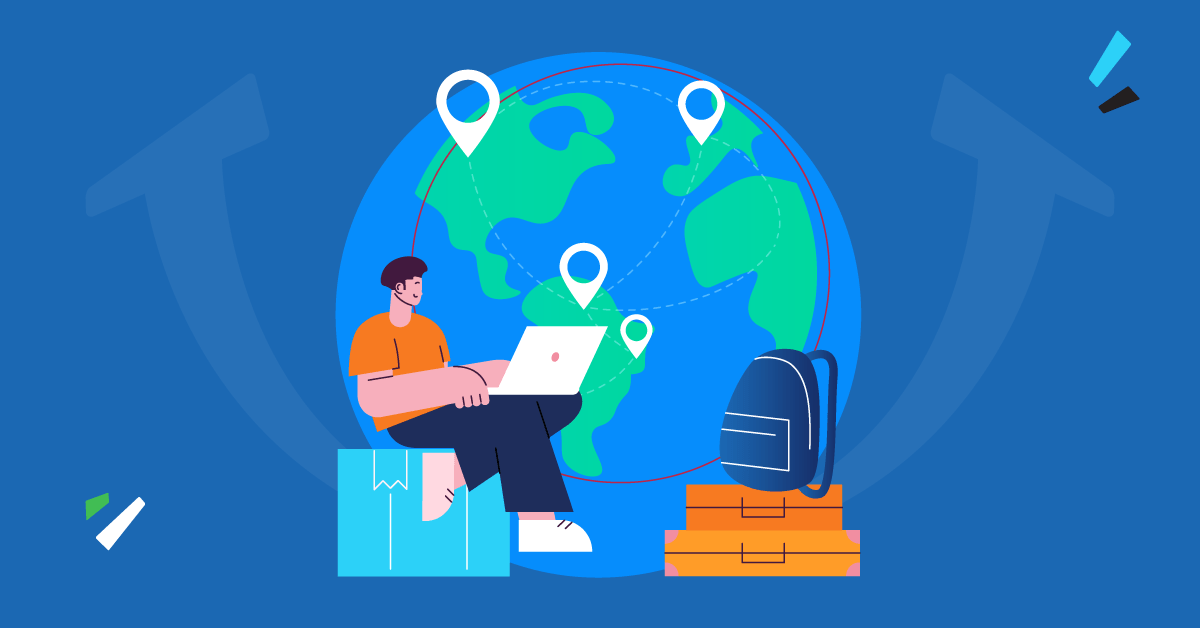Training, as we all know, is a crucial part of growth.
The challenge? It can sometimes disrupt workflows or be difficult to schedule, especially when trying to get everyone to participate in the same room (or Zoom) at the same time—that’s synchronous learning.
Asynchronous learning, on the other hand, allows learners to train at their own pace, on their own time zones and schedule. In simple terms, the training is delivered at one time, and the learner engages with it at another.
What does that mean in practice? Flexibility, accessibility, and self-paced learning. And for businesses, it means scalable, consistent workforce training that supports everything from onboarding to leadership development—and everything in between.
In this article, we’ll explore how asynchronous learning helps organizations build smarter, more agile workforces.

What is asynchronous learning?
As mentioned, asynchronous learning is any type of learning that doesn’t happen in real-time. There’s no live instructor, no fixed schedule, and no need for everyone to be in the same place in person (or even online) at the same time.
For example, instead of a typical scheduled training session, a new hire might complete an onboarding module on your company’s LMS, progressing at their own pace. Similarly, learners can review pre-recorded courses, interactive modules, or bite-sized content, accessing resources as needed.
The true beauty of an asynchronous learning environment lies in its flexibility and how it empowers employees to learn when, where, and how it best suits them.
Asynchronous learning vs. Synchronous learning
We’ve gone over the asynchronous learning definition and learned that it’s all about flexibility. But what about its counterpart, synchronous learning?
Synchronous learning is what most people think of when they picture traditional training: everyone gathers at the same time, in the same place (physical or virtual), with a live instructor leading the session.
Here’s a quick summary to clarify the key differences:
It’s not always an either/or situation, of course. Many organizations are embracing hybrid learning, which blends the best of both worlds.
A hybrid approach might involve pre-recorded lectures (asynchronous) followed by a live Q&A session with the instructor (synchronous), or an in-person workshop (synchronous) supplemented with asynchronous online learning resources and follow-up assignments (asynchronous).
Benefits of asynchronous learning in corporate training
Asynchronous learning can be a novel solution to the challenges of traditional corporate training. It’s about maximizing learning impact while minimizing disruption, cost, and logistical headaches.
Here’s a closer look at the key benefits:
1. Upskilling without disruption
The most cut-and-dry advantage of asynchronous learning is its potential to deliver high-quality training without disrupting workflow. Instead of pulling employees away from their core responsibilities for hours or days at a time, asynchronous learning lets them upskill in short bursts, during downtime, or whenever it fits best into their schedule.
2. Increased flexibility and learner control
We all learn differently.
Some of us are visual learners, others prefer hands-on practice and instruction, and some thrive on reading and reflection.
Asynchronous learning helps employees learn in different ways by giving them control over when, where, and how they learn. A working parent can access training materials in the evening, a night-owl can study late at night, and someone who needs extra time to process information can revisit modules at different times, as needed.
3. Cost-effectiveness
Traditional training can be expensive. Think about the costs of travel, venue hire, instructor fees, printed materials… the list goes on. Asynchronous learning significantly reduces these expenses.
While there’s an initial investment in creating the content, that content can be reused countless times, delivering long-term value and a much higher return on investment.
4. Scalability
On a similar note, once you’ve created a training module or asynchronous course, you can deliver it to hundreds or even thousands of learners, across different time zones regardless of their location or start date.
5. Improved knowledge retention
The self-paced, bite-sized nature of asynchronous learning is a recipe for better knowledge retention. Employees can learn at a comfortable pace, revisit materials as needed, reinforce concepts through quizzes and assessments, and apply what they’ve learned in real time.
Best practices for effective asynchronous learning
The biggest mistake people make with asynchronous learning is thinking it’s just about uploading their old presentations and calling it a day. That’s a recipe for disengaged learners and wasted resources.
To truly unlock the power of asynchronous learning, you need to be more strategic.
Below are some asynchronous learning best practices and how an LMS, like TalentLMS, can become your ally.
Use interactive content (videos, quizzes, gamification)
Nobody wants to wade through a wall of text, especially in our digital world, filled with easy-to-access and fun digital content.
If you want your asynchronous learning to stick, you need to make it interactive.
To do that, you need to use short, snappy videos for quick demos, explainer content, or bite-sized lessons.
Combo that with regular quizzes and assessments to check comprehension, but make them low-stakes and even a little bit fun—think “quick check-in,” not “final exam.”
To further enhance that experience, tap into the power of gamification. Points, badges, leaderboards, or other game-like elements can leverage our natural desire to compete and achieve.
Fortunately, you don’t need a PhD in instructional design or a dozen different software programs to make this happen. TalentLMS has built-in features for embedding videos into lectures, creating quizzes, and adding those all-important gamification elements.
Ensure mobile accessibility (on-demand learning)
Gone are the days when learning was confined to a classroom or a desktop computer. Employees now expect to be able to access training materials on any device, at any time.
With TalentLMS, mobile accessibility is built-in. The platform is responsive, plus there’s a dedicated mobile app. This means employees can learn on the go, whether they’re on their commute, waiting for a meeting, or simply prefer to learn on their phone or tablet.
Encourage self-assessments and progress tracking
Self-assessments are all about empowering learners to take ownership of their progress. It’s moving the needle from passive to active.
Provide regular opportunities for employees to check their understanding and see how far they’ve come. This isn’t about high-stakes testing—it’s about providing feedback and reinforcing learning.
TalentLMS offers robust reporting and analytics. Learners can easily see their progress through courses, view their scores, and pinpoint areas where they might need to focus more effort.
Provide structured yet flexible learning paths
Flexibility is a cornerstone of asynchronous learning, but structure is equally crucial. Think of it like providing a roadmap, but letting learners choose their own pace.
Create clear learning paths that guide employees through the material in a logical sequence. This provides a sense of direction and prevents learners from feeling lost or overwhelmed.
With learning paths, you can create sequences of course content, set prerequisites, define completion criteria, and build a clear roadmap—all while giving learners the freedom to move at their own pace.
Use AI-driven recommendations for personalized learning
Personalized learning is all about making sure employees aren’t wasting time on training that’s irrelevant or too basic. For this, AI can be a powerful ally. As a LinkedIn Learning study suggests, 71% of L&D pros are leveraging AI for either exploring, experimenting or integrating AI into their daily workflows. And so, using AI LMSs can help boost your L&D efforts.
AI-powered training platforms can suggest relevant courses or resources online based on an employee’s role, existing skills, and learning history.
TalentLMS is incorporating AI-powered skills-based learning. It can analyze an employee’s role, skills gap, and learning history to suggest courses and resources that directly address their unique needs.
Offer social learning tools (discussion boards or mentorship programs)
Asynchronous learning doesn’t have to mean solitary learning. In fact, incorporating social learning elements can significantly boost engagement and knowledge retention.
Encourage a sense of community by providing ways for learners to interact with each other and with instructors, even without technical support or real-time interaction.
TalentLMS includes built-in discussion forums. These forums provide a space for learners to ask questions, respond, share insights, and collaborate, creating a more vibrant and supportive learning environment.
What asynchronous learning features to look for in your LMS
Many LMS’s and asynchronous learning platforms claim to support asynchronous learning, but it’s important to look beyond the basic features. A truly effective asynchronous LMS needs to empower you to create engaging experiences, track progress effectively, and develop a sense of connection.
Consider these key features:
- Assessments and surveys: Create quizzes, tests, assignments, and surveys to track progress and gather feedback.
- Learning paths: Create a clear sequence of courses and modules and define completion criteria, guiding learners through a logical progression while still leaving them to learn at their own pace.
- Discussion boards: Provide a space for learners to ask questions, get clarification, share insights, and connect with peers and instructors.
- Mobile accessibility: Ensure that learners can access courses and resources anytime, anywhere, on any device.
- AI course creator tool: Build interactive courses, embed multimedia content, and design assessments directly from your LMS.
- AI skills-based learning: Identify skill gaps, suggest online learning courses, generate skill-based report, build a skills library.
Final thoughts: The future is in asynchronous learning
The future of work is increasingly flexible, distributed, and skills-focused, and asynchronous learning is perfectly positioned to meet those demands.
Investing in the right tools and strategies for asynchronous learning isn’t just about keeping up—it’s about getting ahead. It’s about building a more engaged, skilled, and adaptable workforce, ready to tackle whatever challenges the future may hold.
And with a platform like TalentLMS, you can make that future a reality.
Originally published on: 02 Mar 2021 | Tags: Corporate Training,eLearning Courses,Hybrid Learning,Remote Training




